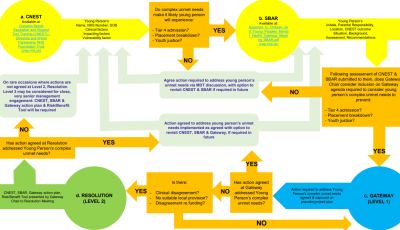Cheshire and Merseyside Complex Needs Framework:
CNEST, Gateway (Level 1) and Resolution (Levels 2-4)

A CNEST should be completed for all young people accessing specialist community CYPMH services, to Identify their unmet needs. Clinicians should work across all agencies and share appropriate information to meet the needs of a young person and family. If CNEST completion indicates a young person's needs are considered high on the rating matrix, action to address their complex, unmet needs may be discussed via the Gateway meeting.
Multi-agency Gateway meetings are held in each of the 9 Places across Cheshire and Merseyside to agree action and address complex unmet needs of young people experiencing moderate to severe mental health difficulties and/or high levels of risk of self-harm and suicide and are:
- at risk of admission to Tier 4 CAMHS
- awaiting discharge from Tier 4 CAMHS
- delayed discharge from Paediatric wards
- at risk of care placement breakdown
- at risk of custody
Gateway meetings (Level 1) are designed to ensure that the local system takes collective responsibility for care and welfare of their young people. If action to address complex unmet needs is not achieved via discussion at the Gateway meeting, Resolution meeting (Levels 2-4) may be required. Professionals requiring assistance in preparing for Gateway (Level 1) and Resolution (Levels 2-4) are invited to visit our introduction pages for the operational checklist.
The Complex Needs Escalation Support Framework for Cheshire and Merseyside is aligned to the following key principles:
|
Resolution meetings at Place may be convened when:
- there is significant clinical disagreement about the needs of the young person
- there is no suitable provision available locally for the young person
- there is disagreement about funding for provision for the young person
Resolution meetings at Place involve senior professionals from the Local Authority, CYPMH provider, acute trust and health commissioner. The Place Director may also be included. For any Resolution meeting beyond the Gateway meeting at Level 1, a risk/benefit analysis should be completed alongside the SBAR. This information will support professionals attending Resolution at Levels 2-4 in understanding the young person’s needs and relevant considerations concerning different care settings: this should be completed in collaboration with all agencies involved, with guidance from the Gateway Chair.
Professionals requiring assistance in preparing for Gateway (Level 1) and Resolution (Levels 2-4) are invited to review our introduction pages for the operational checklist.
If significant disagreement persists at Place concerning needs, provision or funding, an ICB Resolution meeting may be sought by the Place Director. Cheshire and Merseyside ICB cannot direct Local Authorities or individual provider funding decisions but Resolution at this stage is intended to facilitate discussions between commissioners and providers. This should only happen in exceptional circumstances.
Professionals requiring assistance in preparing for Gateway (Level 1) and Resolution (Levels 2-4) are invited to visit our introduction pages for the operational checklist.
If significant disagreement persists at Place concerning needs, provision or funding, and ICB level Resolution meeting has not achieved an agreement as to action to address the young person's complex unmet needs, an NHSE NW region Resolution meeting may be sought by the Place Director. This should only happen in exceptional circumstances.
Professionals requiring assistance in preparing for Gateway (Level 1) and Resolution (Levels 2-4) are invited to visit our introduction pages for the operational checklist.
|
Table 1 Acronym Guide: A&E: Accident and Emergency Department AOT: Adolescent Outreach Team CNEST: Complex Needs Escalation Support Tool CYP: Children and Young People CYPMH: Children and Young People's Mental Health DSD: Dynamic Support Database HON: Head of Nursing ICS: Integrated Care System LA: Local Authority LPC: Lead Provider Collaborative SBAR: Situation Background Assessment Recommendations SRO: Senior Responsible Officer
Level 1: Gateway Meeting (scheduled for regular intervals, with option to meet urgently)
|
||||
|
Criteria |
Referral Process |
Lead Agency |
Membership (may vary) |
Responsibilities of Attendees |
|
CYP at risk of admission to Tier 4 CAMHS
CYP medically fit for discharge and remaining in the current environment (usually acute ward, A&E, paediatrics, Tier 4) is not in their best interests and is deemed unsafe. |
CNEST High or DSD Red plus SBAR |
Multi-agency (Chair = usually health commissioner) |
As determined by Gateway Terms of Reference: Place Based Commissioner LA Social Care – Social Work Manager Acute Trust – Ward Manager / Matron Tier 4 AOT Service Tier 4 LPC (Clinical Case Manager / Commissioning) Community CYPMH Transitions Teams Education Acute Trust Named Nurse for Safeguarding |
Regular, scheduled meetings to discuss CYPs at risk of admission, with a multi-agency response to support needs.
Group agrees shared ownership of risk, with a solution focussed approach.
To agree and implement solutions (ie from formulation and care plan).
To be assured that internal escalations have been undertaken for acute trust, MH, social care.
To understand legal status, capacity/consent, ensure access to advocacy is available. |
|
Level 2: Place Based Resolution meeting
|
||||
|
Criteria |
Referral Process |
Lead Agency |
Membership (may vary) |
Responsibilities of Attendees |
|
CYP remains in an unsafe/inappropriate environment and there is disagreement about the care pathway or no timely solution available. |
CNEST DSD SBAR Risk/Benefit analysis |
(Chair = usually health senior commissioner/lead) |
The same agencies but more senior members. Place Senior Commissioners / Place Associate Director of Quality LA Director Children’s Services Community CYPMH Trust Associate Director Acute Trust Director / Chief Nurse / HON Tier 4 CAMHS LPC Director (if appropriate) |
Facilitate a discussion and consensus on a clinical formulation if this has not been reached at Level 1.
Ability to make decisions/agree plans that are outside of current service provisions. |
|
Level 3: Cheshire and Merseyside Integrated Care Board Resolution meeting
|
||||
|
Criteria |
Referral Process |
Lead Agency |
Membership (may vary) |
Responsibilities of Attendees |
|
CYP remains in an unsafe/inappropriate environment and there is disagreement about the care pathway or no timely solution available. |
CNEST DSD SBAR Risk/Benefit analysis |
Place (chair – usually place director) |
Executive Director of Nursing and Care (ICS) SRO CYPMH ICS Place Director or Associate Director of Quality LA Director Children’s Services / Exec Community CYPMH Trust Associate Director Acute Trust Director / Chief Nurse / HON Tier 4 CAMHS LPC Director (if appropriate) |
To support solutions at place level and ensure that the decision makers are involved from all agencies.
To be assured that there is a clear understanding of the legal status, capacity, consent and rights.
If there are ongoing disagreements about clinical formulation, the Executive Director of Nursing & Care should facilitate a dialogue, involving relevant medical directors.
Recognise themes/ gaps in commissioning.
Notification to NW NHSE Regional Team when Level 3 escalation threshold reached and share plan/agreed solution at this point for assurance. |
|
Level 4: Regional NHSE Resolution
|
||||
|
Criteria |
Referral Process |
Lead Agency |
Membership (may vary) |
Responsibilities of Attendees |
|
This should be the exception with all cases resolved at Place or ICB level. |
Email england. |
Place Director |
Key representatives from Level 3 Regional SRO Regional Team |
To be assured that levels 1-3 have been followed appropriately, when all local escalation processes exhausted, but with retained responsibility remaining locally. |

